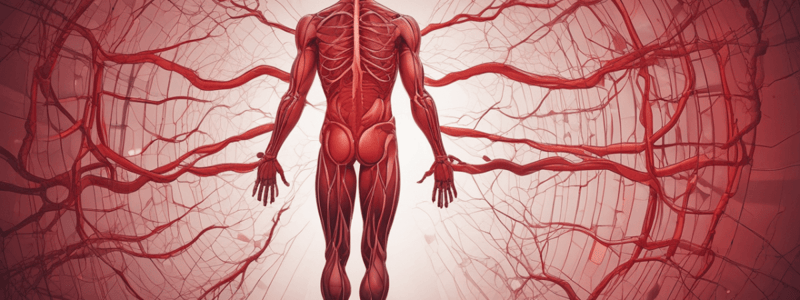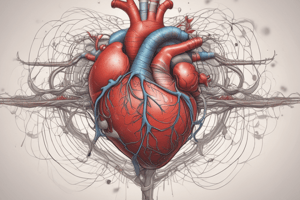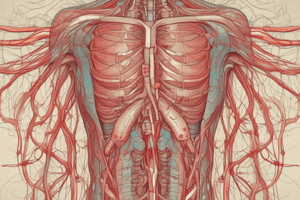Podcast
Questions and Answers
What is the approximate volume of blood in an average adult?
What is the approximate volume of blood in an average adult?
- 10 liters
- 5 liters (correct)
- 2 liters
- 7 liters
What is the main function of albumins in plasma?
What is the main function of albumins in plasma?
- Clotting
- Lipid transport
- Osmotic pressure maintenance (correct)
- Immunity
What is the pH range of oxygen-rich blood?
What is the pH range of oxygen-rich blood?
- 7.35-7.45 (correct)
- 7.0-7.5
- 6.5-7.5
- 7.5-8.5
What is the lifespan of erythrocytes?
What is the lifespan of erythrocytes?
What is the function of leukocytes in the blood?
What is the function of leukocytes in the blood?
What is the percentage of water in plasma?
What is the percentage of water in plasma?
What is the name of the staining method used in blood smear analysis?
What is the name of the staining method used in blood smear analysis?
What is the term for variations in RBC size?
What is the term for variations in RBC size?
What is the function of hemoglobin in erythrocytes?
What is the function of hemoglobin in erythrocytes?
What is the percentage of erythrocytes in the hematocrit of men?
What is the percentage of erythrocytes in the hematocrit of men?
What is the primary function of neutrophils?
What is the primary function of neutrophils?
What is the role of eosinophils in the body?
What is the role of eosinophils in the body?
What type of granules are found in basophils?
What type of granules are found in basophils?
What is the function of B cells in the immune system?
What is the function of B cells in the immune system?
What is the origin of platelets in the body?
What is the origin of platelets in the body?
What is the function of α-granules in platelets?
What is the function of α-granules in platelets?
What is the primary function of the bone marrow?
What is the primary function of the bone marrow?
What is the characteristic of megakaryocytes?
What is the characteristic of megakaryocytes?
What type of leukocytes are most numerous in the body?
What type of leukocytes are most numerous in the body?
What is the role of monocytes in the body?
What is the role of monocytes in the body?
Study Notes
Blood Characteristics
- Oxygen-rich blood is brightly red, while oxygen-poor blood is darkly red.
- pH of blood must remain between 7.35-7.45 (slightly alkaline).
- Temperature of blood is slightly higher than body temperature.
- Average adult has about 5 liters of blood (~7-8% of body weight).
- There are approximately 1 billion red blood cells in two to three drops of blood.
Functions of Blood
- Transports gases (O₂, CO₂), nutrients, waste products, processed molecules (e.g., proteins), and regulatory molecules (hormones).
- Regulates pH and osmosis.
- Maintains body temperature.
- Protects against foreign substances.
- Forms clots.
Blood Components
- Hematocrit measures the volume of packed erythrocytes per unit of blood (40-50% for men, 35-45% for women).
- Composition of blood: plasma (55%), cells (45%).
- Erythrocytes (RBCs), leukocytes (WBCs), and platelets make up the formed elements of blood.
Plasma
- Composed of water (90%), proteins (8%), albumins (58%), globulins (38%), clotting proteins (4%), and inorganic salts (0.9%).
- Types of plasma proteins include albumins (osmotic pressure maintenance), globulins (lipid transport, immunity), and fibrinogen (clotting).
Erythrocytes (RBCs)
- Specializations: biconcave shape, no nucleus, contain hemoglobin.
- Lifespan: approximately 120 days.
- Functions: transports oxygen from lungs to tissues and carbon dioxide from tissues to lungs.
- Surface antigens: blood groups A, B, AB, O.
- Hemoglobin structure: 4 polypeptide molecules (CO₂ transport), 4 heme molecules (O₂ transport).
- Types of hemoglobin: oxyhemoglobin (Hb carrying O₂), carbaminohemoglobin (Hb carrying CO₂).
Leukocytes (WBCs)
- Much fewer in number compared to RBCs.
- Defense against disease.
- Types: granulocytes (neutrophils, eosinophils, basophils) and agranulocytes (lymphocytes, monocytes).
- Neutrophils: most numerous, multilobed nucleus, active phagocytes.
- Eosinophils: migrate to sites of allergic reactions, inflammation, and parasitic infection.
- Basophils: initiators of the inflammatory process.
- Lymphocytes: types include B cells (humoral immunity), T cells (cellular immunity), and natural killer cells (attack cancerous and virally infected cells).
- Monocytes: become macrophages in connective tissue, phagocytosis, produce cytokines, and present antigens.
Platelets (Thrombocytes)
- Origin: fragmentation of megakaryocytes.
- Function: promotes clotting and prevents blood loss.
- Structure: hyalomere (transparent, peripheral zone), granulomere (central zone with granules).
- Granule types: α-granules (contains fibrinogen, PDGF), δ-granules (contains calcium, ADP, ATP), λ-granules (contains hydrolytic enzymes).
Bone Marrow
- Types: red bone marrow (hematogenous) and yellow bone marrow (rich in adipose cells).
- Structure: composed of stroma, hematopoietic cords, and sinusoidal capillaries.
- Function: source of stem cells for other tissues.
- Megakaryocytes: precursors for platelets, exhibit polyploid nuclei with azurophilic granules.
Studying That Suits You
Use AI to generate personalized quizzes and flashcards to suit your learning preferences.
Description
Learn about the physical characteristics, functions, and composition of human blood. Understand the pH, temperature, and volume of blood, as well as its role in transporting gases, nutrients, and waste products.




